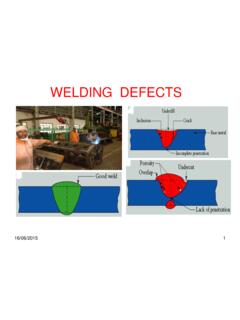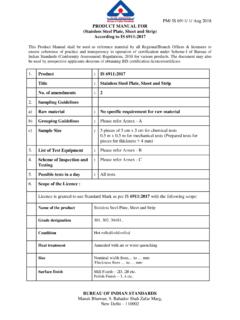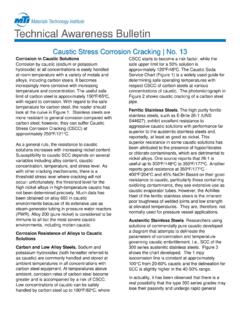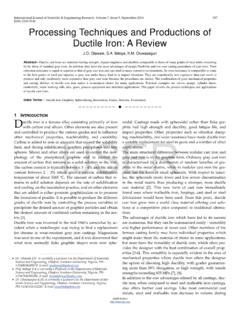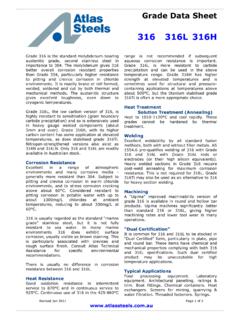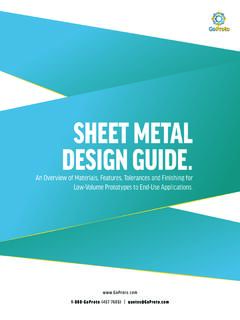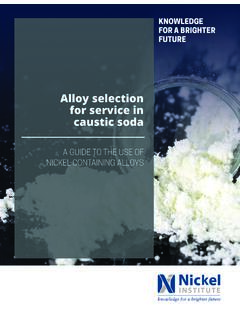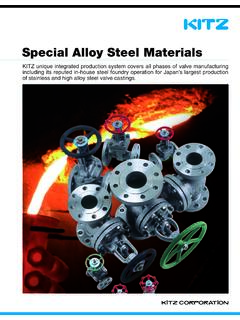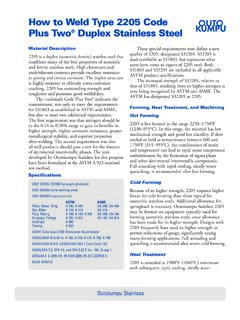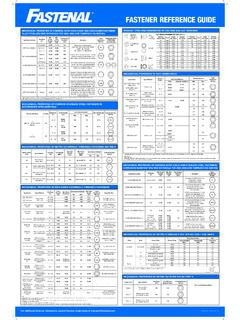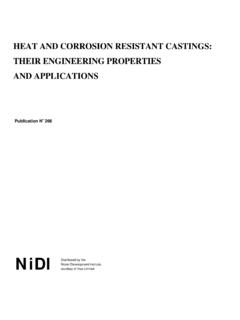Transcription of HEAT TREATMENT
1 HEAT TREATMENT Heat TREATMENT process of controlled heating and cooling of metals Alter their physical and mechanical properties without changing the product shape sometimes takes place inadvertently due to manufacturing processes that either heat or cool the metal such as welding or forming. Heat TREATMENT DEFINATION: A combination of heating & cooling operation timed & applied to a metal or alloy in the solid state in a way that will produce desired Metal Hand Book (ASM) Heat TREATMENT Often associated with increasing the strength of material Can also be used to obtain certain manufacturing objectives like To improve machining & formability, To restore ductility To recover grain size etc. Known as Process Heat TREATMENT Heat TREATMENT Heat TREATMENT done for one of the following objective: Hardening. Softening. Property modification. Heat TREATMENT Hardening heat treatments particularly suitable for Steels Many phase transformation involved even in plain carbon steel and low-alloy steel.
2 Other type of heat treatments equally applicable to ferrous & non-ferrous Hardening Heat TREATMENT Hardening of steels is done to increase the strength and wear properties. Hardening (Quenching followed by Tempering) is intended for improving the mechanical properties of steel. Generally increases hardness at the cost of toughness Hardening Heat TREATMENT Pre-requisites for hardening is sufficient carbon and/or alloy content. Sufficient Carbon - Direct hardening/Case hardening. Otherwise- Case hardening Hardening Heat TREATMENT Common Hardening Heat Treatments: Direct Hardening Heating Quenching Tempering Austempering Martempering Case Hardening Case carburizing Hardening Heat TREATMENT Case Hardening ( ) Case Nitriding Case Carbo-nitriding or Cyaniding Flame hardening Induction hardening etc Precipitation Hardening Heat TREATMENT Temperatures Hardening Heat TREATMENT An act of Heating to austenizing range, 30 500C above Ac3 (Hypoeutectoid) or Ac1 (Hypereutectoid) Holding sufficiently long time for full transformation (1hr/per inch of maxm.)
3 Thickness) Dipping in Quench Medium Hardening Heat TREATMENT Result Avoidance of normal Ferritic-Pearlitic transformation Formation of a hard & brittle structure known as Martensite. Mechanism of Quenching Austenite to Ferrite transformation takes place by a time dependant process of Nucleation & Growth Under slow or moderate cooling rates, the carbon atoms diffuse out of the austenite structure (FCC) forming ferrite (BCC) & cementite (Orthorhombic) With increase in cooling rate, time allowed is insufficient Mechanism of Quenching Although some movement of carbon atoms take place The structure can not be BCC The carbon is trapped in solution The resultant structure, Martensite is a supersaturated solution of carbon trapped in a body centered tetragonal structure (BCT). Quenching Quenched steel (Martensite) Highly stressed condition Too brittle for any practical purpose. Quenching is always followed by tempering to Reduce the brittleness.
4 Relieve the internal stresses caused by hardening. Martensite Tempering Tempering means subsequent heating to a specific intermediate temperature and holding for specific time Tempering leads to the decomposition of martensite into ferrite-cementite mixture Strongly affects all properties of steel. At low tempering temperature (up to 2000C or 2500C), Hardness changes only to a small extent True tensile strength increases Bending strength increases Tempering This may be explained by separation of carbon atom from the martensite lattice corresponding reduction in its stressed state and accicularity Tempering Higher tempering temperature reduces Hardness True tensile strength Yield point While relative elongation and reduction area increases. This is due to formation of ferrite and cementite mixture.. Tempering At still higher temperature or holding time Spherodisation of cementite Coarsening of ferrite grains Leads to fall in hardness as well as toughness Hardening Heat TREATMENT Some features of Hardening Heat TREATMENT Retained ferrite detrimental to uniform properties so heating beyond Ac3 for Hypoeutectoid steel Retained Cementite is beneficial as it is more hard & wear resistant than martensite so heating beyond Ac1, not ACM, for Hepereutechtoid steel Hardening Heat TREATMENT Some features of Hardening Heat TREATMENT ( ) Addition of C shifts TTT curve to right and increases hardness of martensite Addition of Alloy elements shifts TTT curve to right and changes the shape Higher the Alloy% - Higher the stability of M Higher the degree of super cooling Higher the amount of retained Austenite.
5 Temper Embrittleness A sharp fall in Impact strength when tempered at 2500C to 4000C for extended hours All steels, in varying degree, suffer from this Carbon steels display slight loss of toughness. For alloy steel reduction by 50% to 60% The reason associated with Drecipitation of alloy carbides Decomposition of retained austenite. Temperature range is avoided. Quenching Media Quenching media with increased degree of severity of quenching Normal Cooling Forced Air or draft cooling Oil Polymer Water and Brine Quenching Media quenching medium depends on Material composition Weight of job Aim is to have a cooling rate just bye-passing the nose of TTT curve for minimum stress minimum warping/crack during quenching. Cooling rate varies from surface to core: slower cooling towards centre. Tempering Figure 1. Conventional quenching and tempering process Equiaxed Austenite Grain Pearlite Pearlite at high Magnification (Lamellar arrangement of Cementite & Ferrite) Cementite Ferrite Tempered Martensite Austempering A specially designed quenching technique.
6 Quenched around 315 C (above Ms). Held at this temperature for sufficient time to Homogenize surface & core temperature. Undergo isothermal transformation from Austenite to Bainite. Austempering Bainite has same composition as Pearlite with much finely spaced structure (inter lamellar spacing) is tough as well as hard Suitable for direct use in many application Austempering Austempering process. Bainite in prior Austenite matrix Bainite at high magnification Martempering Also a specially designed quenching technique. Quenched around 315 C (above Ms). Held at this temperature for sufficient time to Homogenize surface & core temperature. Further quenched to MS through MF The structure is martensite Martempering Tempered to get desired combination of Hardness & Toughness Advantage over rapid quenching More dimensional stability Less Warping Less chance of quench crack Less residual stress Martempering Martempering process.
7 Case Hardening Objective is to harden the surface & subsurface selectively to obtain: Hard and wear-resistant surface Tough impact resistant core The best of both worlds Case hardening can be done to all types of plain carbon steels and alloy steels Case Hardening Selectivity is achieved a) For low carbon steels By infusing carbon, boron or nitrogen in the steel by heating in appropriate medium Being Diffusion controlled process, Infusion is selective to surface and subsurface b) For medium & High carbon or Alloy steel By heating the surface selectively followed by Quenching Case Carburizing Heating of low carbon steel in carburizing medium like charcoal Carbon atoms diffuse in job surface Typical depth of carburisation; to 5mm Typical Temperature is about 9500C Quenching to achieve martensite on surface and sub-surface If needed, tempering to refine grain size and reduce stresses Case Nitriding Heating of steel containing Al in nitrogen medium like Nitride salt, Ammonia etc.
8 Typical temperature is about 5300C Nitrogen atoms diffuse in job surface Forms AlN, a very hard & wear resistant compound on surface & sub-surface Typical use is to harden tubes with small wall thickness like rifle barrel etc. Case Carbo-nitriding Heating of low carbon steel containing Al in cynide medium like cynide salt followed by Quenching Typical temperature is about 8500C Nitrogen & Carbon atoms diffuse in job Typical case depth to Forms very hard & wear resistant complex compounds, on surface & sub-surface If needed, tempering to refine grain size and reduce stresses Induction and Flame Hardening Employed for medium & high carbon steel or alloy steels Local heating of the surface only either by flame or induction current Heating to austenizing range, 30 500C above Ac3 (Hypoeutectoid) or Ac1 (Hypereutectoid) Quenching in suitable quenching media If needed, tempering to refine grain size and reduce stresses Precipitation Hardening Also known as Dispersion or Age hardening Applicable to common non-ferrous metals and alloys and some spl.
9 Steels Technique used for strengthening Al (Mg, Cu), Mg, Ti (Al, V) alloys Some variety of SS, Maraging Steel etc. Precipitation Hardening Hardening in steel is mainly due to martensite formation during quenching common non-ferrous metals normally don t respond to quenching A method where finely dispersed second phase precipitates in the primary matrix These precipitations lock the movement of dislocation causing increase in hardness Precipitation Hardening Exploits phenomenon of super- saturation. Nucleation at a relatively high temperature (often just below the solubility limit) Maximise number of precipitate particles. Lower the temperature an hold These particles grow in size The process called aging. Typical dislocation size is 5-30 nm Precipitation Hardening Diffusion's exponential dependence upon temperature makes precipitation strengthening a fairly delicate process. Too little diffusion (under aging) The particles will be too small to impede dislocations effectively Too much diffusion(over aging) Particle will be too large and dispersed to interact with the majority of dislocations Softening Heat TREATMENT Softening Heat TREATMENT done to: Reduce strength or hardness Remove residual stresses Restore ductility Improve toughness Refine grain size necessary when a large amount of cold working, such as cold-rolling or wire drawing been performed Precipitation Hardening Softening Heat TREATMENT Incomplete Annealing Stress Relieving Process Annealing Spherodising Full Annealing Normalizing Stress Relieving To reduce residual stresses in large castings, welded and cold-formed parts.
10 Such parts tend to have stresses due to thermal cycling or work hardening. Parts are heated to 600 - 650 C (1112 - 1202 F) held for about 1 hour or more then slowly cooled in still air. Process Annealing used to treat work-hardened parts made out of low-Carbon steels (< Carbon). In process heat TREATMENT allows the parts to be soft enough to undergo further cold working without fracturing. Process Annealing Temperature raised near the lower critical temperature line A1 i. e. 650 C to 700 C Holding for sufficient time, followed by still air cooling Initially, the strained lattices reorient to reduce internal stresses (recovery) When held long enough, new crystals grow (recrystallisation) Process Annealing Material stays in the same phase through out the process Only change in size, shape and distribution of the grain structure This process is cheaper than either full annealing or normalizing As material is not heated to a very high temperature or cooled in a furnace.

